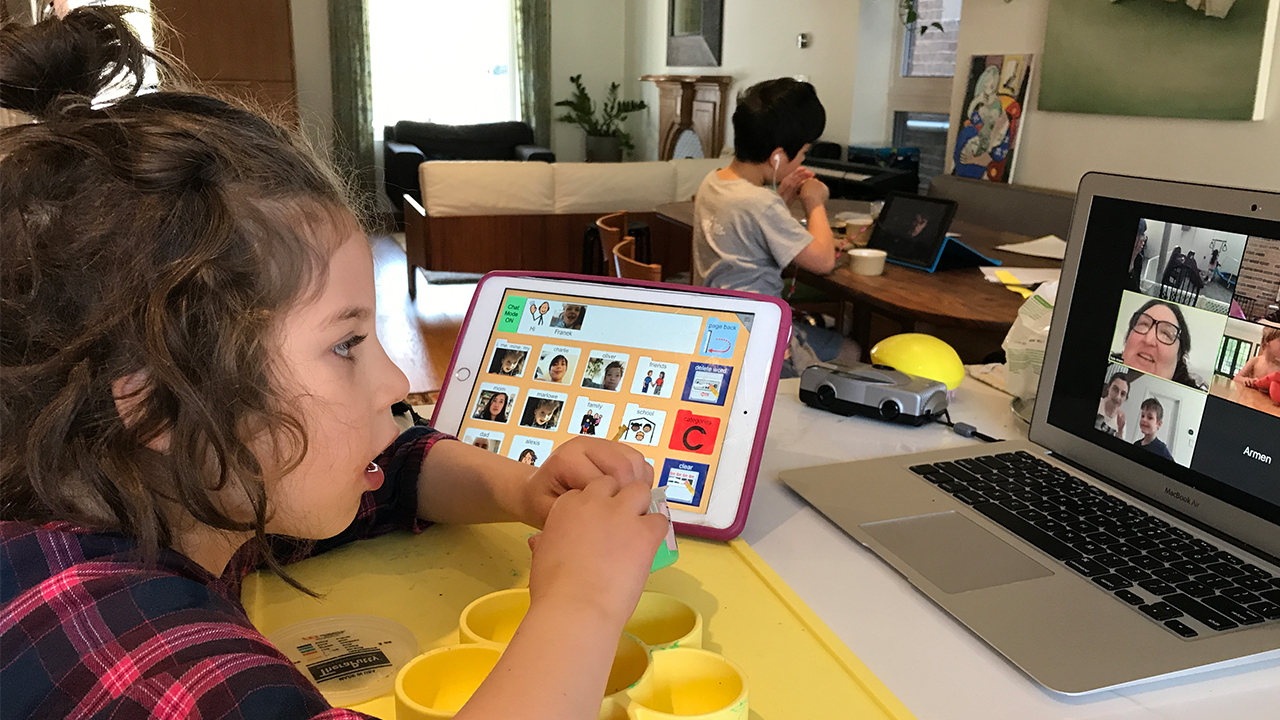Every night is the same. At 3 a.m., I wake in panic, my heart pounding. Is she awake? What’s that sound? Is she smashing her head against the wall again?
I haven’t slept for eight hours straight in 12 years, and it’s not because I have three young kids (Oliver, 12, Charlie 10, and Marlowe, 7). Marlowe has a rare neurogenetic disorder called Angelman Syndrome. She has a biological sleep disorder, experiences seizures almost every day and is globally delayed. She can’t speak (which is extremely frustrating because, like most seven year olds, she has a lot to say), so she bangs her head because it gets an immediate response. In a twisted way, it’s quite smart.
I stumble down the hall to her room. When she sees me, she stops. In the half dark, a smile spreads across her face. A beatific, heart-crushing smile. One of the few upsides of Angelman’s is that, as the name suggests, kids who have it tend to exhibit an inherent sweetness. It’s a neurological byproduct, but with Marlowe, it’s also who she is. My sweet, cuddly, exhausting, relentlessly needy, eternally innocent girl. She holds out her arms, but I stop myself from crawling in beside her. I refill her water bottle, tell her it’s bedtime and say goodnight. I return to my bed, and we both toss and turn until daylight. Her sleep disorder has become my own.
Mornings have always been the hardest part of my day. Just getting the kids out the door and off to school or day camp was a victory. But now, they never leave. They haven’t since March. Breakfast chaos, bickering over who gets the laptop to do email, dragging them all to the park in masks, back-to-back Zoom calls, my older boys bouncing off the walls, while their sister rips posters off their walls because the tape and the ripping sound is sensory and pleasing. There are tantrums every other hour and often they are mine. This is the texture of my days at the moment, with no discernible end in sight.
I know I’m far from alone. Pandemic life has been brutal for so many families. But the difference with ours is that my husband and I were already exhausted before the pandemic. And as Marlowe’s primary caregiver, that is especially true for me. My daughter has complex care needs and requires eyeballs on her at all times, 15+ hours per day. She is smart, curious and highly mobile. She needs help with all her personal needs—feeding, dressing, bathing and going to the toilet. I love her with every ounce of my being, but all this on repeat for months (is anyone still counting days?), until the wee hours of the morning, and I’m near my breaking point.
In many ways, having a child with significant disabilities prepared me for the pandemic. Fear and the unknown have been my close companions for many years. I have an extensive online community of support. I rarely go out for dinner. In career terms, I am queen of the “pivot” and have shifted from dancer to publicist to clothing designer and—inspired by caring for Marlowe—I have retrained as a neuromovement practitioner. Marlowe’s gift to me has been the lesson that I’m good in crisis. Turning lemons into lemonade is my thing.
But she’s also taught me this: I need help.
When Marlowe was diagnosed, the geneticist at SickKids told me she would need a lifetime of support, and so would I. She also explained that help was available. Before the pandemic, Marlowe attended school full-time, she participated in music and arts programming, Sunday afternoon respite, and day camp at a local farm. All that fun and learning for Marlowe, and support for me, has vanished.
I currently get less than one hour of funding per day to hire a personal support worker for Marlowe. This is so unsustainable that many families like ours have hired full-time help out of pocket, and we’d do the same in flash, if we could afford it. My husband was recently laid off, and with all my career shifts and forced “opt outs” over the years of caring for Marlowe, we have never financially recovered. I earned more in my 20s than I do in my 40s, which is a common story for many working moms. But in our case, it’s complicated by my daughter’s needs, which will not go away. Even if we did have deep pockets, finding a qualified caregiver isn’t easy. You can’t just ask the teenager down the street to help when your kid has complexities.
I’ve done all the things you’re supposed to do. I’ve written to my MP, campaigned my community—I even sent a call to action directly to my province’s health minister, trying to draw attention to this devastating gap in the system. As a former publicist, I’m used to pitching and getting declined, but this time, the silence stung. Families like mine have been hung out to dry.
School and quality care is not just a privilege but a right for Canadian children under the UN Convention on Universal Rights of the Child, which Canada ratified in 1991. Other social democracies in Europe and elsewhere, many with COVID-19 rates far higher than our own, have made sure families like ours didn’t fall through the cracks—the UK, for instance, and Norway. These nations have found a safe way to send kids to camp and school, and more crucially, provided support to kids with complex needs. But Canada, a G7 nation that prides itself on its public health and education system, has failed spectacularly. I voted for Justin Trudeau twice. In my eyes, he was the hands-on dad Prime Minister who wore his heart on his sleeve, leading a government that had my back. A couple of weeks ago, I found out otherwise. It was announced that people with disabilities and their families would receive a one-time payment of $600 to help navigate the extra challenges. On my special needs community chat, the response was universal: too little too late. One mom compared it to the paltry $50 extra offered at the outset of the pandemic for children with special needs, to support their home learning. “Just about 95% short,” she quipped. It’s funny because it’s true–but I was too tired to laugh.
Lockdown sucked, but my husband and I buckled down and got through it. But now it’s over, Toronto is in Stage 3 of reopening, and we are still alone. Families like mine have requested flexibility to use what funding they do get to hire friends or family to keep their bubble safe and have been forbidden to do so. We complain to each other privately, in closed Facebook and Whatsapp groups. We know we need to speak up and loudly outside these bubbles about the frustration, despair and burnout, but on the rare occasion one of us musters the energy, the government silence is deafening.
It’s 1 a.m. as I write this. Marlowe and the boys are sound asleep. It’s been more than four months since the lockdown began and it hasn’t all been awful.
We go to the beach often and collect sea glass. Charlie is making a mosaic and has dyed his hair blue. Oliver has started a video editing business and has been compiling recorded birthday greetings for family and friends.
Marlowe’s doing Zoom school to support her communication skills. She has an iPad with symbolic language—we call it her “talker.” She’s developed the ability to point her finger—which is huge—and is using her new skill to make clear requests for her favourite foods and shows.

Photo: Courtesy of Toni Brem
As her functional communication increases, the head banging is happening less and less. The problem is that in spite of her improvements, I’m starting to falter—each day the dread mounts. When will it end? I cry and snap more than I’d like to admit, more than ever before. The strain on my marriage is heavy. I feel ashamed, bereft, ignored.
Even on the rare occasion Marlowe sleeps right through, I’m still up at 3 a.m. Every single night.
What I’m thinking as I lie in bed in the dark is this: Canada, how did it come to this? Why is no one listening? We cannot manage this alone.
The post During coronavirus, families like mine have been hung out to dry appeared first on Today’s Parent.



